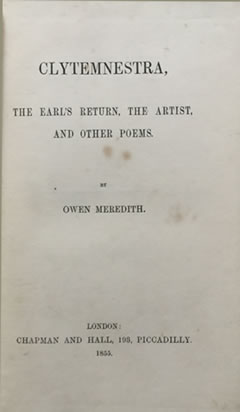Clytemnestra, The Earl's Return, The Artist, and Other Poems
You may click on the thumbnail images to view them full screen

Meredith, Owen. Clytemnestra, The Earl's Return, The Artist, and Other Poems. London: Chapman and Hall, 1855. (Contains the poems: 'The Parting of Lancelot and Guenevere'; 'Elayne le Blanc'; 'Queen Guenevere.')
The theme of the Lady of Shalott was taken up by Owen Meredith (pseudonym of Edward Robert Bulwer-Lytton [1831-1891], the son of Edward Bulwer-Lytton) in two poems. In 'Elayne le Blanc,' Meredith describes the loneliness of the woman called 'the White Flower of Astolat,' who sits in her tower and sings songs that reflect her sad state. The poem does not end with the death of Elayne but merely with her sighting of Lancelot riding to Camelot, where each knight fights in tournament with 'his lady's sleeve upon his helm.' Meredith, who in his poem 'Queen Guenevere' praised the beauty of the queen, wrote another poem called 'The Parting of Launcelot and Guenevere,' the parting being when Launcelot leaves for the tournament in which he wears the favor of Elaine of Astolat. But as in 'Elayne le Blanc,' Meredith does not bring the episode to the point that is the climax in his source. He is concerned with the actual parting, made difficult because of tension in the relationship between the lovers. Despite the queen's aloofness, Launcelot kisses her and their passion resurfaces. Yet Meredith depends for the effect of his poem on the larger story. The tension, Guenevere's insecurities, Launcelot's sense of being misunderstood by her—all are present in the action of this poem; but the reader familiar with Malory knows that they are small matters compared to the crises that arise as a result of the tournament.